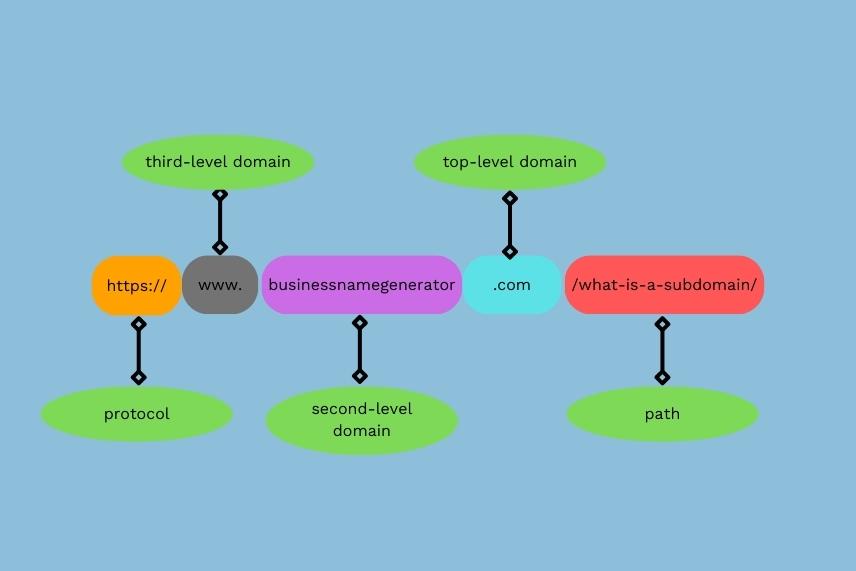What Is a Subdomain for a Website?
A subdomain is an optional appendage to your domain name that can help you organize and categorize different sections of your website. You can use multiple subdomains to create varying structures and content hierarchies under the same domain name. For example, you can create an online store with a different look from your blog.
In this article, we’ll explain what a subdomain is, how it works, and how you can easily set it up.
| Key Points |
|---|
| – Subdomains are independent sections within your website. – Subdomains allow you to use different designs and create varying content structures. – Search engines treat subdomains as separate websites, making them tricky for SEO. |
How to Recognize a Subdomain
Before getting into subdomains, we must understand domain names and their structures. When you visit a URL, you’ll see it consists of several elements separated by a dot or a slash. For example, if you check out the URL you’re currently on, you’ll read https://www.businessnamegenerator.com/what-is-a-subdomain/. Its elements are as follows:
- https:// – Protocol that allows data to travel between a web server and your browser.
- www – Known as the third-level domain, it usually refers to the website’s host.
- businessnamegenerator – This is the unique part of your domain name (called the second-level domain).
- .com – Top-level domain (TLD, or extension) that can provide information about the geographic location, type of content or website purpose. The most common TLDs are .com, .net, .us, and .co.
- what-is-a-subdomain – Called a path, shows the exact location of a specific page or post you’re on.
When you choose a domain name, you have to pick a name and domain type you’re sure of as you can’t change them later on. The only thing you can edit is the third-level domain, often known as a subdomain. For example, instead of having www.domainName.com, you can have shop.domainName.com.
Think of your domain name as your online address. The extension shows what city you’re in, and the second-level domain shows where your apartment is. When you enter your apartment, you have different rooms that serve various purposes. For example, you might have an office for your customers in there, and you may also have a storage room that you don’t want anyone else to see. Subdomains are the rooms you can organize independently of other rooms and give access to different sets of users.
MORE: Learn who owns a domain name
With a registered domain name, you can create up to 500 subdomains, and they can have sub-subdomains (e.g., global.news.domainName.com) with a limit of 63 characters per subdomain level.
What Is a Subdomain Used For?
Let’s imagine you’re a popular digital artist called Dan Digidy. People know about you because of your successful website, dandigidy.com. Now, you want to sell your art, but you want to have a separate website homepage with a different design, menu buttons, and so on. All similar domain names are taken, so you either have to choose a dodgy domain type or a name nobody will remember.
That’s where subdomains come in. You can use your domain name to create store.dandigidy.com and a new website. You can also add a separate WordPress installation on it and create an online store from scratch.
MORE: Learn how to buy a domain name.
Common Reasons Subdomains Are Used
Most commonly, companies use subdomains for two reasons:
- Content organization: It lets users know what section of the website they’re on and what they can expect to get or learn. As a website manager, you can use subdomains to create different content hierarchies (i.e., how you arrange information).
- Testing: Website admins use subdomains only they can access to test out new designs and backend updates before they make them public.
What Is a Subdomain Example?
You can create subdomains any way you want, but you should stick with the most common subdomain types to keep it simple for the users. In addition, using a common subdomain is intuitive, and your visitors will immediately know what to expect. For instance, when you visit store.website.com, you’re probably there to shop.
Check out some of the most popular subdomain examples and their uses:
| Subdomain Use | Explanation | Subdomain Examples |
|---|---|---|
| Ecommerce | Using a separate subdomain can help you install specialized functionalities, such as managing transactions. | – store.yourDomain.com – shop.yourDomain.com – buy.yourDomain.com – deals.yourDomain.com |
| Mobile | A subdomain dedicated to mobile users; it allows you to use a design made for mobile interfaces and optimized for user experience on smaller devices. | – m.yourDomain.com – mobile.yourDomain.com – msite.yourDomain.com – touch.yourDomain.com |
| Blog | With a blog subdomain, you can target keywords and talk about topics different from your main site. | – blog.yourDomain.com – journal.yourDomain.com – learn.yourDomain.com – resources.yourDomain.com – articles.yourDomain.com – news.yourDomain.com |
| Support | Allows you to make dedicated support platforms for your customers. | – support.yourDomain.com – contact.yourDomain.com – help.yourDomain.com – helpdesk.yourDomain.com – assistance.yourDomain.com |
| Location | Great for creating geo-specific content and displaying local store options. | – us.yourDomain.com – uk.yourDomain.com – tokyo.yourDomain.com – it.yourDomain.com |
| Language | If you run a website in several languages, you can use subdomains to keep them separate. Wikipedia is a great example of language subdomain use. | – en.yourDomain.com – it.yourDomain.com – fr.yourDomain.com – pt.yourDomain.com |
| Audience | You can create platforms with varying levels of permissions for your users. Some websites, such as Medium.com, allow you to create your own subdomain and display your content there. | – developers.yourDomain.com – student.yourDomain.com – username.yourDomain.com |
| Forum | You can keep your community neatly organized with a dedicated subdomain for forums and discussion boards. | – forum.yourDomain.com – community.yourDomain.com – ask.yourDomain.com – discussion.yourDomain.com |
Pros and Cons of Subdomains
As with any other decision, choosing to set up a subdomain comes with its pros and cons, and you should weigh your options before committing to creating an independent entity within your website.
Pros
- Subdomains are great for maintaining your brand positioning and using its recognition. If people know about your website, they’ll automatically see the connection between it and the subdomain.
- Allow you to streamline your website and offer better onsite navigation.
- SEO benefits, such as building authority and less concerns about keyword cannibalization.
Cons
- Running subdomains requires putting in extra work.
- Navigating between subdomains can be difficult, negatively affecting user experience.
- Becoming your own competitor if you’re not careful about your content strategies.
Subdomains vs. Subdirectories
Subdomains are not the only way to structure your website content; you can also use subdirectories. Unlike subdomains that come before the domain name, subdirectories come after. For instance, the word blog can be used as a:
- Subdomain: blog.yourDomain.com
- Subdirectory: www.yourDomain.com/blog
Essentially, think of subdomains as separate hardware drives on your computer, while subdirectories are folders on the same drive.
Check out the table below to learn more about the differences between the two:
| Subdomains | Subdirectories |
|---|---|
| – Search engines see them as separate websites. – They have an independent SEO ranking. – You have to build up your SEO from scratch. | – They are part of the main website. – You can benefit from established backlinks and authority. – Subdirectories can’t be used as independent entities. – You must be in line with content from other subdirectories. |
Subdomains and SEO
One of the main benefits of subdomains is the fact that, while your overall SEO authority may disperse, you can use subdomains to focus on a particular set of keywords. This way, Google will know exactly what your website is about, and you’ll be able to establish yourself as a strong niche authority with your subdomains. Additionally, you don’t have to worry about keyword cannibalization.
However, if you have an established website, you already know how difficult it is to build up an SEO ranking from scratch. You can’t rely on already-built backlinks. Subdirectories allow you to build on your existing SEO efforts and further establish your authority. However, they come with technical limitations, such as using the same server, not being able to set up international sites, and not using a dedicated platform.
If you opt for subdomains, you should focus on targeting specific keywords and topics within each subdomain. You can improve your authority individually by getting a different set of backlinks and linking between the two domains. According to Brian Dean, only 2.2% of internet content gets links from multiple websites, so you can improve your linking with subdomains.
When it comes to SEO strategies for subdirectories, linking between different subdirectories helps with internal linking. It’s also easier for Google to crawl subfolders, and tracking analytics is more efficient. If you’re not sure that having an independent entity with its own SEO ranking is crucial, using subfolders is more efficient and may be the better choice for you.
How to Create a Subdomain
Creating a subdomain will depend on the domain registrar or hosting provider you use. Still, the process should be similar and easy to complete. For example, to add a subdomain on GoDaddy, all you need to do is the following:
- Sign in to your GoDaddy account
- Select the domain you want to add a subdomain to and click on the three dots for additional options
- Choose Edit DNS
- Select Add New Record
- Choose A from the Type menu and enter the subdomain name
- Save the new record
New subdomains can take up to 48 hours to become available.
Takeaway Points
A subdomain is a great organizing tool for your website. For example, if you run an ecommerce store, managing transactions becomes important only during the purchasing process. With a shopping subdomain, you wouldn’t need transaction functionality to clutter your main website.
Search engines treat subdomains as separate websites, meaning that you’ll need to start your SEO from scratch. Before you choose to use subdomains, make sure you have a good reason for it and weigh all the pros and cons.
Regardless of how many subdomains you have, users will still recognize you by your main domain name. It needs to be easy to remember, spell, and in line with your brand identity. If you’re having trouble coming up with a high-quality domain name, use our AI-powered domain name generator for free.

